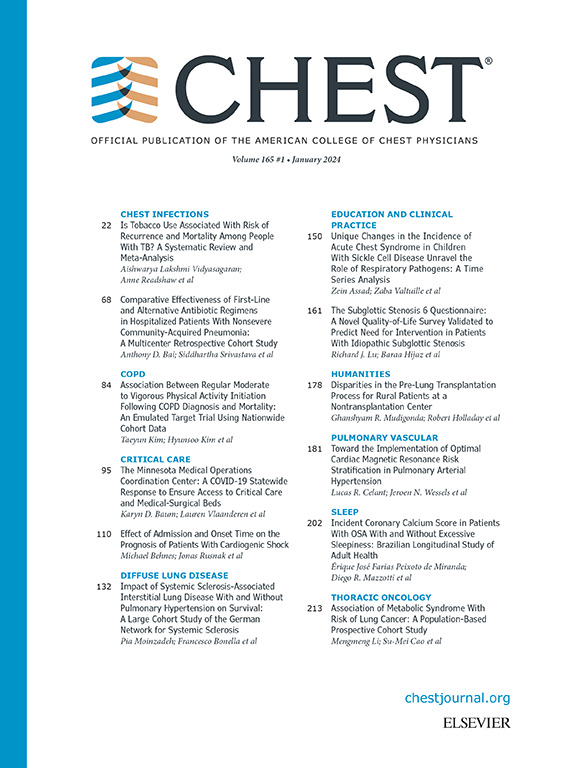预测美国30年的阻塞性睡眠呼吸暂停负担。
IF 9.5
1区 医学
Q1 CRITICAL CARE MEDICINE
引用次数: 0
摘要
阻塞性睡眠呼吸暂停(OSA)是一种常见的疾病,在美国与主要的公共卫生和经济负担相关。先前的研究评估了当前OSA的患病率,但指导了公共卫生政策和管理途径目的:估计到2050年美国OSA的负担。设计、环境和参与者:在本模型研究中,美国OSA患病率的历史数据提取自先前发表的纵向队列研究。美国人口特征(年龄、性别)从相关且有效的人口数据来源获得,身体质量指数(BMI)数据来自国家健康与营养检查调查(NHANES)和威斯康星睡眠队列。为了预测2050年的OSA负担(病例和患病率),建立了一个开放队列动态人群马尔可夫模型。结果基于美国年龄、性别和BMI人口分布的预测变化,该模型预测阻塞性睡眠呼吸暂停(OSA)在未来30年将显著上升。到2050年,预计OSA (AHI≥5/h)的患病率将增加35%至46%,达到7700万例。我们估计,女性将出现较大的相对增长,增加64%,达到3000万例,而男性预计将出现较温和的增长,从19%增加到55%,即4600万例。结论和相关性在这项对未来OSA负担的建模研究中,预测表明,到2050年,OSA将影响美国近7700万30-69岁的成年人,其中女性的相对增长不成比例。这些发现强调,迫切需要有针对性的公共卫生战略,修改获得诊断和随访途径,以解决OSA日益流行的问题,特别是在女性中。本文章由计算机程序翻译,如有差异,请以英文原文为准。
Projecting the 30-Year Burden of Obstructive Sleep Apnea in the United States.
IMPORTANCE
Obstructive sleep apnea (OSA) is a common disorder that is associated with major public health and economic burden across the United States (U.S.). Previous studies assessed the current-day prevalence of OSA, but to guide public health policies and management pathways OBJECTIVE: To estimate the burden of OSA across the U.S. through 2050.
DESIGN, SETTING, AND PARTICIPANTS
In this modeling study, historical data on OSA prevalence in the U.S. were extracted from a previously published longitudinal cohort study. U.S. Population characteristics (age, sex) were obtained from relevant and validated population data sources, and data on body mass index (BMI) were obtained from the National Health and Nutrition Examination Survey (NHANES) and the Wisconsin Sleep Cohort.
MAIN OUTCOMES AND MEASURES
To project the OSA burden (cases and prevalence) into 2050, an open cohort dynamic population Markov model was developed.
RESULTS
Based on projected changes in U.S. age, sex, and BMI population distributions, the model predicts a significant rise in obstructive sleep apnea (OSA) over the next three decades. By 2050, the prevalence of OSA (AHI≥5/h) is expected to increase by 35% to 46%, resulting in 77 million cases. We estimate that females will see a larger relative increase, with a 64% rise to 30 million cases, while males are projected to experience a more moderate increase of 19% to 55%, or 46 million cases.
CONCLUSIONS AND RELEVANCE
In this modeling study of future OSA burden, projections indicate that OSA will affect nearly 77 million adults aged 30-69 years across the U.S. into 2050, with disproportionate relative growth among females. These findings highlight the urgent need for targeted public health strategies and revise access to diagnosis and follow-up pathways to address the growing prevalence of OSA, particularly among females.
求助全文
通过发布文献求助,成功后即可免费获取论文全文。
去求助
来源期刊

Chest
医学-呼吸系统
CiteScore
13.70
自引率
3.10%
发文量
3369
审稿时长
15 days
期刊介绍:
At CHEST, our mission is to revolutionize patient care through the collaboration of multidisciplinary clinicians in the fields of pulmonary, critical care, and sleep medicine. We achieve this by publishing cutting-edge clinical research that addresses current challenges and brings forth future advancements. To enhance understanding in a rapidly evolving field, CHEST also features review articles, commentaries, and facilitates discussions on emerging controversies. We place great emphasis on scientific rigor, employing a rigorous peer review process, and ensuring all accepted content is published online within two weeks.
 求助内容:
求助内容: 应助结果提醒方式:
应助结果提醒方式:


